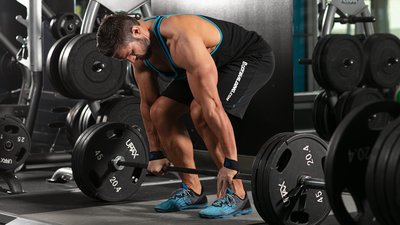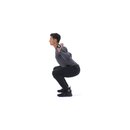What if I told you that many, if not most physique enthusiasts are missing a major component in their training, one that would accelerate their physique goals and gains? If they gave it a try, they'd look harder, get leaner, push more weight with better form, and be more capable and confident in the weight room.
What is it? In four words: old school strength training. And no, I'm not talking about barbell bent presses or other long-lost lifts—although, for the record, they're great. I'm talking about doing the same lifts you do now, only in a different way.
Old-time strongmen like Eugene Sandow, widely considered the father of bodybuilding, trained purely for strength, and their physiques were a combination of diet and their training. I can hear some of you ask, "Strength—you mean, super-heavy, bloody-nose-inducing lifting like a powerlifter?" Not necessarily.
Many of the old-time greats had to perform feats of strength onstage on a regular basis to make a living, so body-destroying max efforts which required days of recovery weren't an option.
Instead, they trained strength much as someone would learn to play the piano or tennis, or throw the javelin; they treated it as a skill to be practiced. The more they practiced, the more they perfected their strength and the stronger—and leaner, and more muscular—they became.
Strength Is A Skill
This style of training, repopularized in the West about 15 years ago by Pavel Tsatsouline, proceeds from the idea that your best strength gains will be made when you train fresh, frequently, and without fatigue. It is, in essence, the exact opposite of the push-beyond-the-limit way most people approach their time in the weight room.
In skill training, there is no pump, only a little heavy breathing, and not much sweat. Rest periods are long—up to 5 minutes—and sets are short, noticeably lacking any sort of "intensity technique" such as rest-pause, dropsets, or supersets. Reps are kept purposefully low, like 1-5. And the number of sets per exercise is around 3-5.
Workout programs are also different: Instead of "blasting" and "trashing" a muscle, or your entire body, you lovingly cultivate it, like you would a plant, training it frequently. Usually, you'll train somewhere around 3-5 times per week, more often than not repeating exercises on those days.
If this sounds strange, think of it like tennis again. If you were learning the game you wouldn't practice your serves and volleys until your arm fell off, and then have your training partner shout, "Two more! It's all you bro!" Why not? Because, tennis is a skill. Weightlifting is a skill. And skills are best learned, acquired, and refined while fresh and without fatigue. If you want to be able to practice it again in just a day or two, you'll need to have something left in the tank.
Why Skill-Strength Training Works For Physique Goals
Spending time each year focusing on building your strength works great for three main reasons:
1. Skill-strength training builds a harder muscle
Muscles can look soft and puffy, or they can look hard and tight—and I'm not talking about the hard and tight that comes from doing carb, sodium, and water manipulation during photo shoot prep. I'm talking about hard all the time. The best way to build this type of muscle is training low reps, heavy weights.
This is because you're training your type 2b muscle fibers, which increases the size of your muscles myofibrils—the actual muscle fibers, not just the sarcoplasm—the gelatin-like goo that surrounds your muscles.
The growth resulting from the traditional bodybuilding rep ranges of 8-15 reps, on the other hand, largely takes place in the sarcoplasm.
Just because you do fewer reps and rest more does not mean your workload is easier. Your heart rate will rise as your effort requires.
2. Skill-strength training burns
I once did an experiment as a young lifter. I worked up to a 5RM max on the squat and wore a heart rate monitor. My HR was 177 bpm, which was approximately 90 percent of my max heart rate at the time. Lifting heavy requires hard work. And yes, you will end up breathing heavy and sweating—even if it's not on purpose.
Your type 2b muscle fibers are the ones most responsible for lifting heavy weights. They're also the largest and strongest muscle fibers in your body, and as such, they require the most energy to work. Work them more frequently, and you'll burn more energy.
3. Skill-strength training helps
Here's something else cool about your type 2b fibers: A study done at Boston University in 2008 concluded that training heavy can reduce fat levels and improve overall metabolic parameters without any change in diet. It also makes you healthier overall, enabling the liver to metabolize fat, which simultaneously improves your ability to eat carbs and not have them turn into fat. That means you'll need potentially less cardio to lean out.
"Yeah, but just look at powerlifters!" you say. My response: Just look at most Chinese Olympic weightlifters. They do virtually nothing but lift heavy all the time. And ultimately—let's face it—if you're really worried about weight gain or weight loss during this style of training, that's between you and the plate, my friend.
I know much of what I'm saying goes against what gets written about bodybuilding and body composition training these days, but strength-skill training can make a big difference in your physique. It lays the foundation for future gains, both in muscle and in ability.
If you stall in your progress, or if you tend to demand more from yourself than you are currently able to deliver, you owe it to yourself to give it a try.
How To Program Skill-Strength Training
What would a "strength-skill" workout look like? It'd be built around classic compound movements like the bench press, squat, deadlift, and military press. You would move weights that are heavy but not overwhelming, and never go anywhere near failure.
Build your strength skill workout around compound lifts. Think of weightlifting as a skill, not just a physical means to an aesthetic end.
Here's an example of a week's worth of workouts in this style:

BodyFit
$6.99/month- 2,500+ expert-created single workouts
- 3,500+ how-to exercise videos
- Detailed workout instruction
- Step-by-step workout tips
- Training at gym or at home
- Access to Workout Plans
- Access to Bodyfit App
- Store Discounts
Already have a Bodybuilding.com account with BodyFit? Sign In

What comes with BodyFit?

- Instructional Videos
Don't risk doing a workout improperly! Avoid injury and keep your form in check with in-depth instructional videos.

- How-to Images
View our enormous library of workout photos and see exactly how each exercise should be done before you give it a shot.

- Step-by-Step Instructions
Quickly read through our step-by-step directions to ensure you're doing each workout correctly the first time, every time.

BodyFit
$6.99/month- 2,500+ expert-created single workouts
- 3,500+ how-to exercise videos
- Detailed workout instruction
- Step-by-step workout tips
- Training at gym or at home
- Access to Workout Plans
- Access to Bodyfit App
- Store Discounts
Already have a Bodybuilding.com account with BodyFit? Sign In

What comes with BodyFit?

- Instructional Videos
Don't risk doing a workout improperly! Avoid injury and keep your form in check with in-depth instructional videos.

- How-to Images
View our enormous library of workout photos and see exactly how each exercise should be done before you give it a shot.

- Step-by-Step Instructions
Quickly read through our step-by-step directions to ensure you're doing each workout correctly the first time, every time.

BodyFit
$6.99/month- 2,500+ expert-created single workouts
- 3,500+ how-to exercise videos
- Detailed workout instruction
- Step-by-step workout tips
- Training at gym or at home
- Access to Workout Plans
- Access to Bodyfit App
- Store Discounts
Already have a Bodybuilding.com account with BodyFit? Sign In

What comes with BodyFit?

- Instructional Videos
Don't risk doing a workout improperly! Avoid injury and keep your form in check with in-depth instructional videos.

- How-to Images
View our enormous library of workout photos and see exactly how each exercise should be done before you give it a shot.

- Step-by-Step Instructions
Quickly read through our step-by-step directions to ensure you're doing each workout correctly the first time, every time.
You alternate workouts like these for weeks, rarely getting close to your max, and letting the overall stimulus do its work. You also truly rest on your days off except for some easy walking, which is always good for you, no matter your goal.
To get the most out of your skill-strength training, I recommend you program your entire next year out in advance. Use the classic 12-week training template advocated by great powerlifting strength coaches like Marty Gallagher. Set up four 12-week cycles per year, with four weeks of active rest a year, one after each 12-week cycle.
- Weeks 1-13: Train 12 weeks, rest 1 week
- Weeks 14-26: Train 12 weeks, rest 1 week
- Weeks 27-39: Train 12 weeks, rest 1 week
- Weeks 40-52: Train 12 weeks, rest 1 week
Next, decide how many cycles of strength-skill work you want to do. I recommend using six-week blocks or cycles. You could pair one six-week strength-skill cycle with a traditional six-week cycle of traditional bodybuilding/physique work and do this four times per year. Or you could do two six-week strength-skill cycles each year: one during the first six months of the year, and one the second six months of the year.
Finally, pick the exercises you need to work on the most—the ones that will have the biggest impact on your physique—and take advantage of this opportunity to learn to do them well. Examples include squats, bench presses, military presses, deadlifts, chin-ups, rows, and parallel dips. I recommend picking one or two per body part and sticking with them for the entire six weeks without changing them. Only change your sets and reps.
Along the way, aside from the strength and muscle you build, you'll become a better bencher, squatter, and puller. No matter what your goals are down the road, that will help you achieve them.
References
- Izuyima Y et al. Fast/Glycolytic muscle fiber growth reduces fat mass and improves metabolic parameters in obese mice. Cell Metab. 2008 Feb;7(2):159-72.






